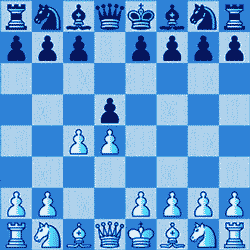Queen's Gambit of Grandmasters
by AJ Brown
(New York, NY)
Perhaps one of the deadliest gambits in chess is the Queen's Gambit. "Gambit" is chess slang for a strategic chess opening, and gambits are the point of study for many chess enthusiasts. Gambits usually include some form of "material sacrifice", usually a pawn or another ancillary piece that does not hold value to the player, in order to open up a chess board, develop a strategy further, or to expose weaknesses in the opponent's line.
Gambits were first described in the 14th century by a Spanish priest by the name of Rúy López de Segura; the gambit, derived from an Italian expression meaning "to trip with one's leg", was thought by Padre Rúy to be an instrumental piece of a player's game. The earlier in a match that an opponent can be weakened, leading to control of the board and quick checkmates, the better.
A gambit, when presented on a chess board, can either be "accepted" or "declined" by the opponent. To "accept" a gambit means to capture the piece that is offered in the gambit, or to "take the bait". To "decline" the gambit means to either fortify a piece that is threatened by the gambit or to develop the board in other sectors.
Grandmasters are well-versed in how to respond to either situation, with the opponent's decision to accept or decline the gambit a major identifier as to how the game will progress. Chess has evolved to a point where many players are often willing to accept gambits, with the logic in mind that they will probably later sacrifice a piece of equal value when it is advantageous for them to do so.

Queen's Gambit - Gambit of Grandmasters
The Queen's Gambit, a specific kind of gambit with many variations, in particular, is cited as a favorite of grandmasters such as Bobby Fischer and Gioachino Greco. The Queen's Gambit generally involves moving pawns to c4 and d4, respectively (as White). This allows for the White Queen to control most of the bottom-leftmost quadrant of the board. General chess theory stipulates that White playing d4 will initiate a response by Black of d5, at which point the gambit is made by d4.
In the accepted variant, this surrendering of the center by Black provides White with the opportunity to further develop pieces, such as e3 and Nf3, while Black attempts to slow White's progress. White will usually indulge in kingside castling to protect the King, and Black is usually willing to sacrifice at least a pawn or other piece of similar value to compensate for taking White's gambit.
If declined, also known as "the Orthodox Line", Black generally favors to hold the center and develop pieces such as their Bishop, Knight, or other pawns. In this scenario, White's response is normally to quickly attack black to hold up its development of the center by Bg5 or Nc3.
The danger with the Queen's Gambit, and the indisputable reason it is the deadliest gambit in the world, is due to the immense pressure placed on white to ensure its Queen, the most powerful piece in the game, is protected. While the advantages of opening up the Queen's side of the board, especially by c4 and d4, are many, including a projection of power and ease of access to the Queen, players must be weary that their development of c4 and d4 are not met with a counter-attack that leaves the Queen pinned amongst its own pieces, helpless to defend both itself and the King at the same time as watching other pieces.
In many regards, the Queen's Gambit is not a true gambit, because, as mentioned, as opposed to traditional gambits where a player makes a sacrifice of material and positioning without expecting to capture anything in return. In the Queen's Gambit, most players understand that their sacrifice is more like "tit-for-tat", and that they will soon even up the board by capturing an opponent's piece via sacrifice later on in the game.
While certainly not as dangerous as the King's Gambit in which the King may be left unprotected without the bonus of having the extraordinary projection of power of the Queen, most chess players recognize the absolute folly of initiating the King's Gambit unless the player is a grandmaster with undeniable methods of securing victory on the chess board, and will prefer the Queen's Gambit to the King's Gambit as a way of developing good position in the center.
When playing the Queen's Gambit, players are most weary of the Albin Countergambit, in which black responds to white's advance by developing e5. While rarely seen in professional play, it is often used in amateur games and is seen as a suitable response to a White Queen's Gambit that, in addition to offering a countergambit to the game, develops the Black Queen to control the right side of the chess board.
Perhaps the most popular string of games utilizing the Queen's Gambit occurred during the 1927 World Chess Championship, in which José Raúl Capablanca and Alexander Alekhine squared off in a total of thirty-four games, thirty-two of them starting with variants of the Queen's Gambit. These games have been reprinted in numerous chess strategy books and exemplify some of the finest, most deadly gambits ever played in the history of the game.
Further reading on the Queen's Gambit
Comments for Queen's Gambit of Grandmasters
|
||
|
||







